Today, Xiaobian from the falling film evaporation process, typical evaporation crystallization separation process, MVR technology and application of three areas, detailed take you into the world of evaporation crystallization, not to mention, dry goods.
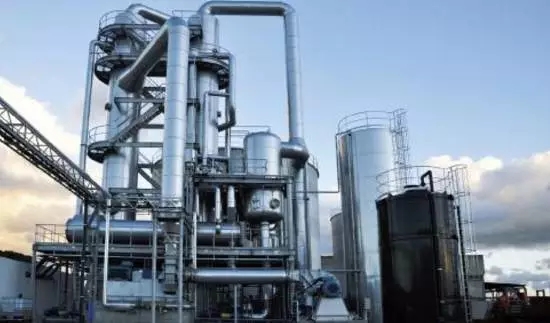
Brief introduction of falling film evaporation process
Evaporation (or distillation) is an ancient method, but because of the continuous improvement and development of technology, this method is still the main method of concentrating or making fresh water.
The essence of the distillation process is the formation of water vapor, the principle is like the evaporation of sea water to form a cloud, the cloud under certain conditions to form a cold rain, and the rain is not salty.
According to the energy, equipment and process, it can be divided into multi effect evaporation, multi-stage flash evaporation, vapor compression evaporation (MVR) and so on.
1. multi effect evaporation technology
(1) principle:
Multi effect evaporation is a system consisting of single effect evaporation. The two steam produced by the former evaporator is introduced into the next evaporator as the heating steam and condensed into distilled water in the next evaporator.
Raw water enters the system mode: there are counter flow, advection (respectively into each effect), parallel flow (from the first effect into) and counterflow preheating and flow into the material.
(2) advantages (multistage flash comparison)
The heat transfer process of multi effect evaporation is boiling and condensation heat transfer, and it is phase change heat transfer, so the heat transfer coefficient is very high. In general, the heat transfer area of multi effect evaporation is less than that of multi-stage flash evaporation.
Multi effect evaporation is usually a passing evaporation, unlike a multi-stage flash as a large number of liquid circulation in the equipment, so less power consumption;
High concentration ratio of multi effect evaporation;
The elasticity of multi effect evaporation is large.
(3) classification of process of multi effect evaporation
There are three kinds of multi effect evaporation process, which are downstream, countercurrent and flow.
A. downstream:
Refers to the liquid and heating steam is in the first effect to the second effect of the order of progress.
Characteristic:
The vacuum degree of multi effect increases successively, that is, absolute pressure decreases successively;
Therefore, the feed fluid in the transmission between the effect does not need to use the pump, but by pressure difference natural flow to the back of the effect;
The temperature is also reduced in turn, so the feed liquid has an overheating phenomenon before the first effect leading to the latter effect, that is, flash evaporation produces some steam, that is, fresh water;
For the materials with large concentration and large viscosity, the heat transfer coefficient of the latter is relatively low; and because of the large concentration, the boiling point is high, and each effect is not easy to maintain a larger temperature difference, which is not conducive to heat transfer.
B. advection
Advection refers to the parallel feeding of each effect, but the heating steam except the first effect, the other effects are used for the two steam.
Applicable to: easy crystallization of materials, such as salt, once heated evaporation, quickly reached supersaturated state, crystallization precipitation.
In the process of water treatment, the main purpose is to obtain fresh water, without the need for countercurrent and peaceful flow, and the counterflow and the flow have no downstream heat efficiency.
C. countercurrent:
Counter flow means that the feed flow path is opposite to the direction of the heating steam. Raw materials from the highest vacuum at the end of the first effect into the system, gradually to the front of each effect flow, the concentration is higher and higher, so the feed fluid into the front of the first effect, not only did not flash, but also through a preheating process, to achieve boiling.
The advantages and disadvantages of visible and downstream are just the opposite. For high viscosity materials, countercurrent is more suitable, because the last evaporation is the first effect at the highest temperature. Therefore, although the concentration is large, the viscosity can be reduced, and the heat transfer coefficient can be maintained relatively high. This is more used in chemical production.
Introduction of 2. multi effect evaporation process and equipment
According to the analysis of single effect evaporator, the amount of evaporation D/, heating steam D0=0.91, or D0/D=1.1, that is, 1kg steam can evaporate 0.91kg of fresh water.
If the two steam is discharged to the heating chamber of the second evaporators as the heating, then the two 1kg of the same steam can evaporate 0.91kg of fresh water.
And so on, the more the number of effect, the use of 1kg heating steam can evaporate more fresh water, which is beneficial from the use of heat. In fact, the solution boiling phenomenon, pipeline flow resistance loss, the temperature loss, plus more effect, even if the insulation is good, large radiating area, the heat loss also increases, so when the increase of the number of effects, the efficiency of heat utilization also decreases.
Considering the increase of efficiency, the investment of equipment increases, so there is a best point in actual use of efficiency.
Evaporator with 3.3 main components of multi effect evaporation system
(1) immersed tube (ST)
This kind of evaporator is a kind of evaporation equipment immersed in the heating tube. Generalized immersion tube evaporator and a variety of styles, a straight pipe, a coil pipe, U tube and vertical tube, horizontal tube structure.
There are two types of flow in the evaporator: natural convection and forced circulation. This kind of evaporator appears earlier and is easy to operate, but it has serious scaling, high hydrostatic column and large loss of temperature difference. Therefore, the efficiency is not enough, and it is usually below 6 effect.
(2) vertical evaporation (VTE) here refers to the falling film evaporator tube.
The two basic advantages are that the heat transfer coefficient is high due to the vaporization of the film inside the tube and the phase transition on both sides of the heat transfer wall. And the temperature loss caused by static liquid column is eliminated. The concentration rate of the system is relatively high, and the low concentration solution, such as seawater desalination, has a general effect of 11~13 efficiency, and the water making ratio is up to 9~10.
Scaling problem, especially when the liquid distribution is uneven or insufficient water, may form a dry zone on the inner wall of the pipe, and the risk of scaling increases. Therefore, it has higher requirements in scale prevention and scale removal.
Generally speaking, it is not suitable to use MICROTEK method in this kind of evaporation system, which mainly depends on chemical method to prevent fouling and reasonable design of temperature and concentration.
(3) horizontal tube membrane type (HTE)
The evaporator is a circulating liquid, which is formed by the liquid film outside the tube of the cross tube bundle through the spray deviceCondensation of steam (or pre effect two steam) in the tube.
It has the advantages and disadvantages of vertical tube falling film type the same, but the height of equipment than the vertical tube falling film type device for small, compact, all the effect of the spray pipe bundle, and the steam separator are installed in a cylinder body, so the heat loss, low energy consumption.
Because of the low temperature, the fouling and corrosion are greatly reduced, and the higher heat transfer coefficient is ensured. In addition, the vapor phase resistance is small, and the loss of the hydrostatic head is eliminated. The heat transfer temperature difference can be very small, especially suitable for the use of low heat energy.
Application of MVR technology in evaporative crystallization
1. typical evaporation concentration (crystallization) process

(1) single effect evaporation (1kgH2O as an example)
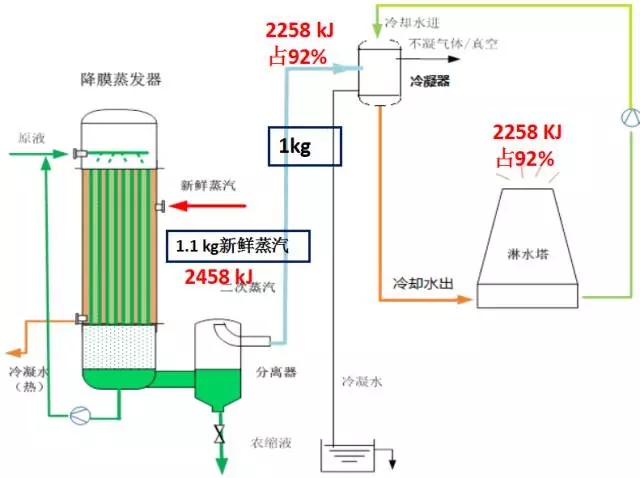
Fresh steam, a large amount of heat → two steam → cooling water → atmosphere, cooling tower consumes a large number of circulating water and power (pump) operation, causing three waste.
(2) the relationship between energy consumption and efficiency (evaporation is 1 t H2O)
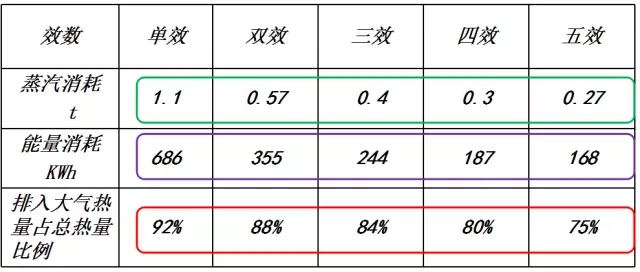
The working principle of 2.MVR
(1) the role of MVR
MVR— mechanical vapor recompression, refers to the evaporation (two steam distillation) process (low temperature and low pressure to use) compressor compression, improve its temperature, pressure, re heating needs to be evaporated as material, so as to achieve the purpose of recycling steam, the evaporation process need for external steam; with a small amount of electricity can get more energy, thereby reducing a high energy saving technology system demand for energy.
(2) characteristics and analysis of MVR heat pump

Flow chart of MVR heat pump
According to the working principle of MVR heat pump system, the efficiency depends on the comparison between the latent heat of recovery and the mechanical work input.
Taking the change of the basic cycle at atmospheric pressure as an example, the simulation shows the advantages in energy efficiency.

Calculation and analysis of MVR heat pump
Seen from the table, the 90. 5 kJ/kg compression power consumption of the system, you can recycle latent heat of 2257.6 kJ/kg, thermal power ratio reached 24.9. The enthalpy of the refrigerant increases by only 0.8%, but its temperature increases by 13%, which is equivalent to the input of a small amount of high grade mechanical energy. However, a large amount of low-grade heat energy is converted into the available high grade heat energy, thus improving the efficiency of energy utilization.
(3) progress of process and technology of MVR system
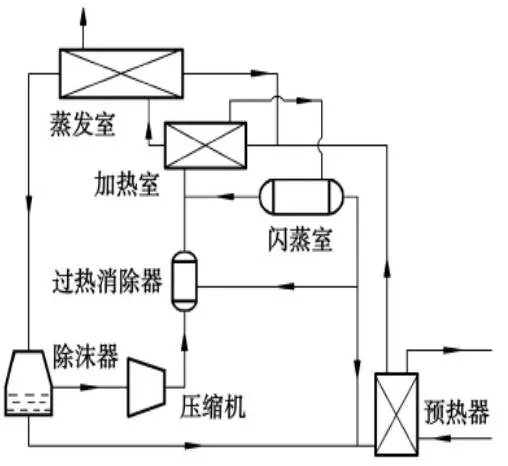
MVR single effect evaporation system
MVR heat pump unit with different treatment process needs to provide appropriate heat transfer temperature difference. In the process of evaporation heat transfer temperature difference and pressure difference and liquid heat treatment, high heat sensitive material suitable for liquid under the condition of small temperature difference gradient multi stages.
The process of MVR heat pump system is also designed as single effect evaporation and multi effect evaporation. The single effect evaporation system has the advantages of simple process and convenient operation. It is suitable for water evaporation, thermal property is weak, allowing large temperature difference heat transfer, only once evaporation can reach the concentration requirements of the solution.
(4) multi effect evaporation process of MVR heat pump
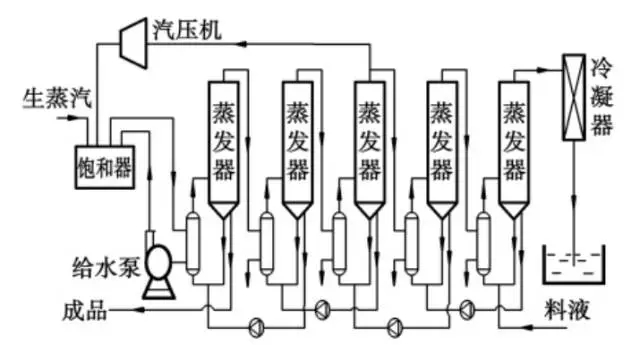
Multi effect evaporation of MVR system is suitable for the treatment of heat sensitive, not suitable for large temperature difference heat transfer solution evaporation, at the same time, it can also be used in the process of large evaporation.
3.MVR system
(1) core process and composition
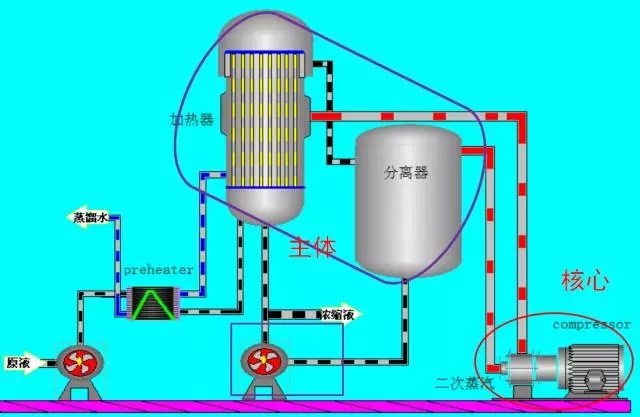
Evaporator: main equipment, including heater, separator, circulating pump. Compressor system: the core equipment, compressed two times steam to provide evaporation heat source, improve the enthalpy of the two steam.
Preheater: utilization of waste heat and improvement of feed temperature
Vacuum system: to maintain the vacuum of the whole system, extract part of non condensable gas from the device and the solution into the gas, so as to achieve a stable state of evaporation system.
Control system: PLC or DCS system. Compressor speed, valve, flow meter, temperature and pressure control, in order to achieve automatic evaporation, cleaning, downtime and other operations. Automatic alarm, system automatic protection, to maintain system dynamic balance.
(2) advantages of MVR

(3) matters needing attention in falling film evaporator
The uniformity of film forming and the thickness of film in the heat exchange tube of falling film evaporator are important guarantee for safe and efficient operation of falling film evaporator;
The effect of cloth solution distributor, heat pipe wall appears uneven film produced is not only the consequence of the evaporation efficiency is greatly reduced, and the heat exchange tube may cause the local temperature is too high, “ dry ” phenomenon, long-term sustainability will significantly reduce the service life.
The uneven evaporation caused by uneven liquid film in the tube will precipitate part of the solute at the tube wall with excessive evaporation and form fouling after its surface is gathered.
In addition, the material contained in the evaporation solution will show strong corrosion characteristics at high temperature, which should be paid attention to during the process design, and can be solved by adopting anti-corrosion heat exchanger materials.
Application of 4.MVR in evaporation crystallization
(1) seawater desalination field
At present, the domestic seawater desalination technology mainly includes reverse osmosis and distillation. Distillation mainly includes multi-stage flash, low temperature multi effect distillation and compressed air distillation (VC). MVR technology is widely used because of its remarkable energy saving.
Basic principle:
The two steam produced by the evaporation process of the sea water is compressed by the compressor, and the saturated temperature of the steam is increased correspondingly, and then is fed into the tube bundle of the evaporator as the heat source of the evaporation of the sea water, and the self condensing is used as the desalination water.
Technological process:

Feed seawater poleAfter a small scale inhibitor is pretreated, it enters a plate heat exchanger, and the concentrated brine and desalinated water discharged from the evaporator are recovered. After that, it is mixed with the circulating concentrated brine, and then enters into the evaporator and is sprayed on the outer surface of the horizontal heat transfer tube bundle. The spray quantity just forms a continuous liquid film on the surface of the pipe, and the steam heat exchange with the compressor in the tube bundle is pressurized. The steam is condensed into fresh water in the tube, and a part of brine outside the tube is evaporated. After the liquid drop out of the separator, the steam enters into the compressor and is introduced into the heat transfer tube, so that the two steam is continuously changed and the latent heat is exchanged. As shown in Figure 2-3 above.
Main advantages and disadvantages:
Compressor distillation is very similar to multi effect distillation. The difference is that the former uses compressors and the latter uses steam to drive them.
Scope of application: suitable for only electric energy, mainly to build small and medium-sized devices.
(2) the field of salt making
The MVR salt making technology can solve the problem of the great increase in the cost caused by the increase of energy price in the existing salt production. It is the best choice for the salt making enterprises to reduce energy consumption, improve the quality of products, reduce production costs and improve economic benefits
Working principle:
The first steam heating the brine to the boiling point, low temperature and low pressure steam from the evaporator two for compressor suction, compressed by compressor adiabatic, improve two steam pressure and the saturation temperature of the heating chamber, and then returned to the original evaporator, as the steam heating. The compressor consumes some useful energy in the process. After heating the steam into the heating chamber, heat is exchanged with the brine to evaporate water, that is, the two steam. The two steam is inhaled by the compressor, forming a cycle process.
Technological process:
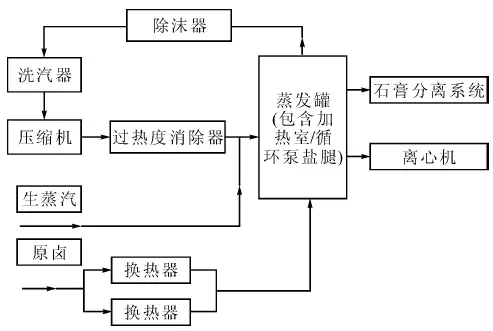
Process flow diagram
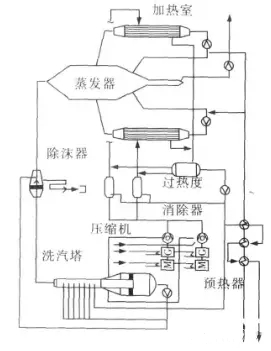
MVR technical drawings
System composition:
Two steam evaporation system, washing system, vapor compression system, compressed steam superheat elimination system, tank brine preheating system, centrifugal drying system, condensate water system, steam system and other systems, according to different materials, usually with brine treatment system, gypsum seed method requires gypsum system. The brine containing Glauber's salt needs the system of extracting nitric acid.
(3) the field of wastewater treatment
Many fields of production wastewater contains large amounts of inorganic salts, such as sodium chloride, sodium sulfate, sodium carbonate and other inorganic salts, which has been one of the difficult problems of wastewater treatment, if the inorganic salt wastewater recycled, these inorganic salts can be used as raw material, saving the cost of production process, avoid resources waste, but also can avoid environmental pollution, resource recycling.
Evaporation principle:
Evaporation principle as shown in the following picture

Technological process:
The pump will be pre heater, concentrated pharmaceutical wastewater treated into MVR in the evaporator in a heat exchanger, cycle of heating, evaporation and concentration of the pharmaceutical wastewater treatment by using steam distilled water, get back to the preheater for preheating, liquid; concentrated liquid and steam into the liquid gas separator. The liquid gas separator, the steam separated into the compressor, and the concentrated liquid is separated directly back to the collecting tank, the concentrate processing Recyclable the useful substances.
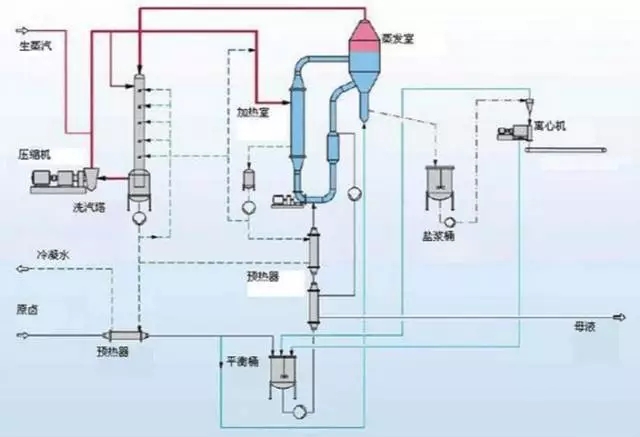
Wastewater field mainly includes petroleum wastewater, perfume wastewater, technical wastewater and chemical wastewater
(4) alkali production from whole bittern
Chlor alkali production has the characteristics of high energy consumption and pollution. Therefore, the ion-exchange membrane caustic soda process must be adopted in the caustic soda industry, and it is necessary to treat weak brine to nearly saturated by using this process to realize alkali production from whole bittern. The ways of removing water include membrane filtration, multi effect evaporation, MVR evaporation, and 4 return wells of weak brine.
MVR evaporation process flow:
The schematic diagram of the process is shown in the diagram:
















